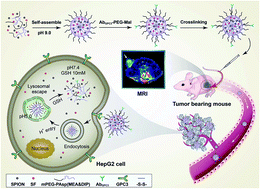A reduction and pH dual-sensitive nanodrug for targeted theranostics in hepatocellular carcinoma†
Abstract
Sorafenib (SF) is the first drug demonstrated to improve the survival of patients diagnosed with advanced-stage hepatocellular carcinoma (HCC). However, its clinical application is limited by the poor oral bioavailability and severe side effects. In this study, a multifunctional micellar nanodrug was developed for simultaneous HCC-targeted delivery of SF and tumor detection with magnetic resonance imaging (MRI). The micellar nanodrug incorporating SF and superparamagnetic iron oxide nanoparticles (SPIONs) was prepared from a diblock copolymer of monomethoxyl poly(ethylene glycol) and poly(N-(2-aminoethanethiol-co-2-aminoethyldiisopropylamine) aspartamide) and then decorated with anti-glypican-3 antibody (AbGPC3). Owing to the small size, weak positive charge and AbGPC3-mediated active targeting to HCC cells, the nanodrug exhibited an easy cellular uptake and enhanced tumor accumulation. The prominent reduction and pH dual-sensitivity allowed the nanodrug to rapidly release SF inside cancer cells via responding to the cytoplasmic glutathione and lysosomal acidity. The nanodrug not only significantly improved the anticancer effects of SF in hepatoma treatment but also facilitated a noninvasive tumor detection and monitoring of in vivo drug delivery by MRI, which revealed its great potential as a promising theranostic system.



 Please wait while we load your content...
Please wait while we load your content...